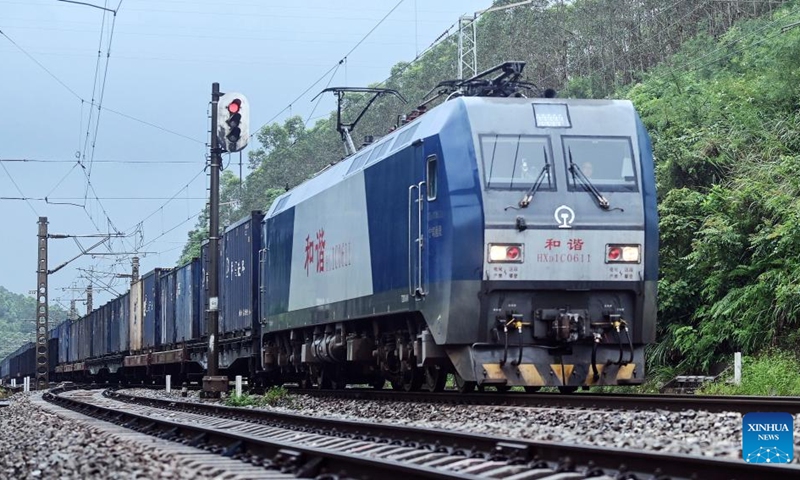GAC unveils measures to boost development of western regions

A train runs on the railway that constitutes part of the New International Land-Sea Trade Corridor on Aug. 2, 2024. As of Aug. 2, 2024, more than 500,000 twenty-foot equivalent unit (TEU) containers for rail-sea intermodal transportation have been delivered via the New International Land-Sea Trade Corridor, the highest level for the same period in all years. The New International Land-Sea Trade Corridor, jointly built by provincial-level regions in western China and ASEAN members, expanded its reach to 490 ports across 120 countries and regions, according to data released in January by southwest China's Chongqing Municipality, the corridor's operational hub. (Photo/Xinhua)
China's General Administration of Customs (GAC) on Sunday unveiled 15 measures aimed at advancing the large-scale development of the country's western regions, with a particular focus on promoting openness. The measures focus on four aspects promoting development through opening-up, advancing advantageous characteristic industries, strengthening security barriers at the border, along assisting in creating a first-class port business environment.
When it comes to boosting big development in the western region through great opening-up, the measures will support the construction of ports across the region, while promoting coordination between opening-up and development. Specifically, the measures will back the opening or expansion of ports in areas that are in need and meet designated criteria, and support the construction of smart ports as well as enhance and improve port functions.
The measures include support for the opening or expansion of ports in eligible areas in need, and the exploration of further measures to facilitate intermodal river-sea and rail-sea transportation. GAC plans to support the construction of international aviation hubs in cities such as Chengdu, Chongqing, Kunming, Xi'an, and Urumqi.
The measures also called for the exploration of reforms such as integrating comprehensive bonded zones and ports in the western region.
The GAC vowed to support the upgrading of traditional industries and the acceleration of characteristic industries. The detailed measures include supporting the western region in developing new quality productive forces tailored to local conditions, assisting traditional industry enterprises in importing advanced technologies, essential equipment, and key components for technological transformation and equipment upgrades, as well as promoting the export of specialty agricultural products.
The GAC stressed facilitating cross-border trade. Specific measures include implementing the Regional Comprehensive Economic Partnership and other free trade agreements with high quality and include ports in western regions as pilot cities for GAC's special action program of promoting cross-border trade.
Moreover, the GAC measures vowed to strengthen the ecological and biological safety barrier at the national border while promoting the safety and stability of industrial and supply chains in key areas such as grain and energy mineral resources. The measures also include strengthening the joint efforts to combat the smuggling of nuclear, biological, and chemical explosives, weapons and ammunition, drugs, while maintaining a high-pressure crackdown on the smuggling of "foreign garbage," ivory, and other endangered animals and plants and related products.
The new measures focusing on trade and logistics facilitation, developing characteristic industries, and other aspects will boost the economic development of the western region. They will also elevate the logistics efficiency and trade facilitation level as well as promote the optimization and upgrading of the industrial structure, Wang Peng, an associate research fellow at the Beijing Academy of Social Sciences, told the Global Times on Sunday.
Wang said measures supporting the development of new quality productive forces and backing traditional enterprises for importing advanced technologies will promote intelligent and automated production processes for local firms, improve production efficiency and product quality that will also boost the innovation vitality of enterprises and further enhance regional competitiveness.
Crucial for opening-up, regional integration
The development of the western region has entered an important phase, especially following the advancement of the Belt and Road Initiative, while cities and regions such as Chengdu, Southwest China's Chongqing Municipality, and Xinjiang have become important pillars for supporting the opening-up, Cong Yi, a professor at the Tianjin School of Administration, told the Global Times on Sunday.
China's western region has been playing a vital role in boosting connectivity with international trade partners. Comprising 12 provincial-level regions, western China covers two-thirds of the country's land area and is home to over a quarter of its population. A sparsely populated area with limited infrastructure, the western regions have lagged economically compared to the eastern provinces, according to Xinhua.
The New International Land-Sea Trade Corridor, a key logistics network connecting China's western regions to global markets - the ASEAN market in particular - surpassed a milestone volume of 10,000 rail-sea intermodal train journeys in 2024, the Xinhua News Agency reported on December 31, citing data from the Beibu Gulf Port Group.
The corridor has elevated the western regions to a vantage point of openness, catalyzing swift economic growth in these areas, which now connects 523 ports across 124 countries and regions, according to another report by Xinhua.
From 2020 to 2023, the total import and export value of the western region increased from 2.96 trillion yuan ($404.34 billion) to 3.74 trillion yuan, with an average annual growth rate of 8.5 percent, which is 1.2 percentage points higher than the national average during the same period, according to GAC data.
The measures also came amid the country's efforts to bolster regional advancement, which will further boost the regional coordinated development.
Wang highlighted the western region's rich energy, mineral, and agriculture resources as major advantages to provide a solid foundation for economic development, while the region's unique geographical and cultural environment offers ample space for advancing tourism and cultural industries.
He added that the western region is an important ecological security barrier and strategic rear base for the country, playing a significant role in maintaining national security and stability.
In December 2024, the GAC announced a new round of 16 measures prioritizing the synergistic development of East China's Yangtze River Delta region, which focuses on supporting the development of new quality productive forces, improving logistics efficiency, upgrading the business environment at ports, ensuring customs check security, and enhancing intelligent governance capability.
Photos
Related Stories
Copyright © 2025 People's Daily Online. All Rights Reserved.









